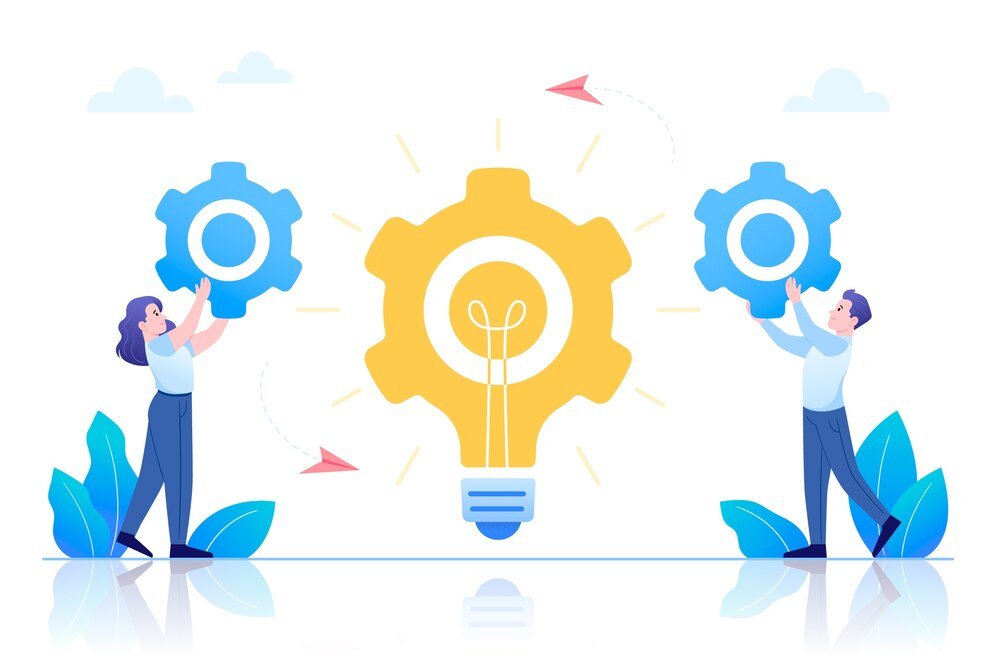In today’s fast-paced business world, the old way of making products doesn’t cut it. Entrepreneurs and startups need a strategy that’s quick and focuses on customers. This is where the Lean Startup methodology shines.
The Lean Startup method is all about quickly making and testing minimum viable products (MVPs). This way, companies can learn fast. By using an “build-measure-learn” cycle, they can keep improving their products with customer feedback. This method helps entrepreneurs lower risks, save time and money, and boost their chances of success.
This article will dive into the Lean Startup methodology’s key principles and steps. We’ll show you how to use these in your business for growth and innovation. Whether you’re starting out or you’re an established business, the Lean Startup approach can be a game-changer.
Table of Contents
Understanding the Lean Startup Methodology
The lean startup methodology was created by Eric Ries. It’s a way to make and manage startups using science. It views a startup as an experiment. It focuses on quick changes and learning from customers, not just planning.
The main ideas of the lean startup process are about managing startups, learning from customers, and always innovating. This cycle of innovation never stops.
What Is Lean Startup Methodology?
This method helps businesses get products to customers faster by using customer feedback. It prefers trying new things instead of sticking to a detailed plan. The goal is to avoid wasting time early on to increase the chance of success later.
The Three Steps: Build, Measure, Learn
- Build a minimum viable product (MVP) to test your business idea.
- Measure customer feedback and metrics to see if the MVP works.
- Learn from the data and decide if you should change your idea or stick with it.
The build-measure-learn cycle is key to the lean startup method. It means building a MVP, checking how it does, and learning from what customers say. This way, entrepreneurs can quickly check if their ideas work and adjust their products to meet what customers want.
“The lean startup methodology is designed to help businesses deliver products to customers at a quicker pace by focusing on validated customer feedback.”
Traditional startups often make detailed plans and financial forecasts before showing their products to investors. The lean startup method is different. It focuses on the customer, uses MVPs, and keeps learning from feedback.
| Lean Startup Methodology | Traditional Startup Approach |
|---|---|
| Focus on customer feedback and validated learning | Extensive business planning and financial projections |
| Iterative development with MVPs | Lengthy product development in secrecy |
| Quickly adapt to customer needs | Secure funding from investors before launching |
Many businesses use the lean startup method to innovate and lower the risk of failure. By focusing on the customer, making MVPs, and always improving based on feedback, entrepreneurs can build successful businesses.
Build Your Minimum Viable Product (MVP)
The first step in the lean startup method is to build a minimum viable product (MVP). This is a basic version of your product with just enough features to learn about your customers. Start by identifying the main problem your product aims to solve. Then, create the simplest version to test your ideas.
Identifying the Problem and Developing an MVP
When making an MVP, focus on the basic features needed to solve the main problem for your audience. This method cuts down on development time and costs. It also gives real data on if customers will use and pay for your product. The MVP process lets you quickly adjust based on customer feedback and market changes.
Examples of Successful MVPs
Many big companies started with a simple MVP to test their ideas and get customer feedback. For instance, Zappos began by listing shoes online with just photos. Dropbox started with a demo video before fully developing their product. Amazon, starting with used college textbooks, now sells millions of products and makes billions, showing a huge growth from a simple idea. Uber’s founders, Garret Camp and Travis Kalanick, first developed UberCab through SMS before creating the popular Uber app we know today.
“The Minimum Lovable Product (MLP) focuses on delivering a customer-centered product that users cherish from the outset, emphasizing maximum customer value and satisfaction.”
Moving from MVP to MLP or Minimum Marketable Product (MMP) shows how product development strategies evolve. They focus on quick market entry, delivering customer value, and testing product viability. By focusing on core features and feedback, startups can improve their products and find a better fit in the market.

This image from freepik
Measure Customer Feedback and Metrics
In the lean startup approach, getting customer feedback and tracking key product metrics is key. This helps validate your Minimum Viable Product (MVP) and guides its development. By using both numbers and opinions, you learn how users like your product and if it meets their needs.
Gathering Data from Your MVP
To get feedback and metrics, you can use different methods, such as:
- Surveys – Online surveys, in-person interviews, and focus groups give you both numbers and stories. They help you see what customers like and what they don’t.
- Analytics – Look at how many new users you get, how many stay, and how many buy. This tells you how well your MVP is doing.
- Experiments and Tests – A/B testing and usability studies prove or disprove ideas and improve your product.
Key Metrics to Track
When checking how your MVP is doing, focus on metrics that matter to your goals and the problems you’re solving. Important metrics include:
- User Acquisition – Shows how well you’re bringing in new customers.
- User Retention – Measures how well you keep users coming back.
- Conversion Rates – Tells you the percentage of users who do what you want, like buy or subscribe.
- Customer Satisfaction – Finds out how happy users are with your product and their experience.
By always collecting and looking at this data, you can check your ideas, find what needs work, and make choices based on facts. This helps guide your product’s growth.
Lean Startup
Validated Learning and Pivoting
The lean startup method is all about the “build-measure-learn” loop. This cycle lets entrepreneurs quickly test their ideas and decide if they should keep going or change direction. By tracking key metrics and learning from customers, startups know when it’s time for a big change.
Lean startups prefer to experiment rather than plan out five years ahead. They start with a minimum viable product (MVP) to get feedback from customers. This helps them avoid the high failure rate that many startups face. By making small changes or big pivots based on feedback, they can stay on track.
Learning from customers is key in the lean startup world. Big companies like General Electric and Intuit have used this method to focus on what customers want. They look at things like how much it costs to get a customer, how much that customer is worth, and how likely they are to leave. This way, they don’t waste time on features customers don’t like.
The lean startup approach is popular worldwide. It shows how entrepreneurship is growing in many places. The Lean Startup movement is making a big impact, helping companies innovate and stay flexible. Lean Impact by Ann Mei Chang even offers ways to make a social difference.

By using validated learning and pivoting, both startups and big companies can move fast and focus on what customers want. This helps them succeed in a changing market.
Benefits of the Lean Startup Approach
The lean startup method is great for entrepreneurs and startups wanting to build successful businesses. It helps you get to market faster, use resources better, and lower startup risks. By following its core principles, you can achieve these benefits.
Faster Time-to-Market
This approach lets you get your product to users quickly. You start with a Minimum Viable Product (MVP) and then improve it based on what customers say. This way, you can test your product fast, learn from users, and make smart updates.
Resource Efficiency
Using the Lean Startup Method cuts down on risks by focusing on learning and validation. It encourages making decisions based on data when launching products. This approach helps you use your resources wisely, cutting down on waste and improving efficiency.
| Lean Startup Benefit | Description |
|---|---|
| Faster Time-to-Market | Rapid experimentation and validation through MVP development |
| Resource Optimization | Efficient use of resources, minimizing waste through the Build-Measure-Learn cycle |
| Startup Risk Reduction | Data-driven decision-making and early validation of ideas |
“The Lean Startup method is a scientific approach to creating and launching successful startups. It teaches you how to drive a startup – how to steer, when to turn, and when to persevere – and grow a business with maximum acceleration.” – Eric Ries, author of “The Lean Startup”
By using the Lean Startup method, you can make your business more agile and responsive. You’ll use resources better and lower startup risks. This way, you can meet changing customer needs and market demands effectively.
Implementing Lean Startup Principles
Starting a lean startup means changing how you think and work. It’s about seeing failures as chances to learn, not just mistakes. This way, teams can quickly try new things, get feedback from customers, and make their products better.
Fostering a Culture of Experimentation
Startups that do well with lean startup have some key traits:
- They use data and customer feedback to make decisions, not just guesses.
- They encourage an entrepreneurial spirit in their teams, letting them try new things and learn from mistakes.
- They follow the lean startup way, always building, testing, learning, and improving.
Embracing Customer Feedback
At the heart of lean startup is focusing on what customers really want. Startups must always be looking to understand what customers need. By listening to what customers say and acting on it, startups can make sure they offer real value.
| Lean Startup Principles | Key Benefits |
|---|---|
| Rapid Experimentation | Faster time-to-market and increased agility |
| Customer-Centric Innovation | Deeper understanding of customer needs and pain points |
| Iterative Development | Efficient allocation of resources and reduced waste |
By adopting the lean startup mindset, startups can really benefit from a culture of trying new things and focusing on customers. This leads to sustainable growth over the long term.

Challenges of the Lean Startup Method
The lean startup method has many benefits but also faces some hurdles. Switching to an experimental, iterative way of working can be tough. Teams used to traditional planning may find it hard to adapt.
Startups need to quickly get customers and their feedback. But, keeping those early customers can be tough. As they grow, startups may lose the agility and focus on customers that lean startups need.
There’s also a risk of spending too much time improving products. Focusing too much on what customers don’t like can lead to endless updates. This can delay when a startup makes money.
Changing the way a company works is another big challenge. Not following industry standards can lead to failure early on. It can also hurt the product’s reputation. Teams in lean startups might lose motivation because of the ups and downs in their work.
| Challenge | Explanation |
|---|---|
| Transitioning to Iterative Work | Moving from traditional planning-driven methods to a more experimental, iterative approach can be difficult for some teams. |
| Customer Acquisition and Retention | Startups must balance the need for rapid customer feedback with the challenges of acquiring and retaining those early adopters. |
| Scaling Challenges | As startups grow, maintaining the agility and customer-centricity required by the lean methodology can become increasingly difficult. |
| Organizational Change | Implementing the lean startup approach often requires significant organizational change, which can be a significant hurdle for some startups. |
| Perpetual Product Development | The risk of endless product improvement exists in lean startups, where an overemphasis on addressing negative feedback can lead to delayed profitability. |
| Loss of Motivation | The iterative nature of the lean startup methodology, with its frequent ups and downs, can lead to a loss of motivation for the team. |
Despite these challenges, the lean startup approach is still a strong tool for startups. It helps them quickly and efficiently develop and test new products and services. By facing these challenges, startups can use the lean startup method to grow and succeed.
Continuous Innovation
The lean startup method is all about a cycle of innovation. This cycle, known as the “build-measure-learn” loop, is key to keeping your products or services fresh and relevant. It helps you stay in tune with what your customers want.
The lean startup loop means always trying new things, getting feedback from customers, and using that feedback to make your products better. This way, businesses can quickly adapt to new trends without sticking to old, set ways of doing things.
By using the lean startup loop, entrepreneurs create a culture of trying new things and seeing what works. They see mistakes as chances to learn, not failures. This helps them test new ideas fast, learn from the results, and make smart choices about what to do next.
The lean startup method isn’t just a one-time thing. It’s a way of always improving and staying up-to-date with what customers need. By always following the “build-measure-learn” cycle, you keep your business flexible and ready for change.
“The only way to win is to learn faster than anyone else.” – Eric Ries, author of “The Lean Startup”
Adopting the lean startup loop means changing how you think. It’s about trying new things, making decisions based on data, and always looking for ways to improve. By encouraging your team to go through the “build-measure-learn” cycle, you set your business up for success in a fast-changing market.
| Statistic | Value |
|---|---|
| Entrepreneurs who found Ries’s lean startup methodologies to challenge traditional business practices | 89% |
| Entrepreneurs whose understanding of successful business building was transformed by Ries’s approach | 73% |
| Entrepreneurs who resonated with Ries’s reframing of failure as a learning opportunity | 94% |
| Readers who found Ries’s writing style in “The Lean Startup” clear, concise, and engaging | 82% |
| Entrepreneurs at various stages who found the book’s theoretical frameworks and actionable advice valuable | 67% |
| Entrepreneurs influenced by Ries’s emphasis on continuous learning and uncertainty | 76% |
| Professionals influenced by Ries’s prioritization of validated learning, customer feedback, and data-driven decision-making in assessments | 95% |

This image from freepik
Lean Startup vs. Traditional Approach
Starting a new business gives entrepreneurs two main choices: the lean startup method or the traditional business plan method. These methods are very different in what they focus on, how they work, and what they aim to achieve.
The lean startup methodology is all about making quick prototypes and improving them step by step. Lean startups aim to create a Minimum Viable Product (MVP) fast to test their ideas. Their plans are short, covering key points like the problem, who it’s for, the solution, what makes it different, and costs. This is unlike traditional business plans, which can be long and detailed, covering everything from company info to financial forecasts.
One big plus of the lean startup way is getting to market fast, which is crucial in competitive fields. Lean startups also stand out to investors with their clear, brief summaries. They look for employees who can adapt and support a culture of trying new things and focusing on what customers want.
| Lean Startup Approach | Traditional Business Plan Approach |
|---|---|
| Rapid prototyping and iterative development | Detailed planning and extensive pre-launch efforts |
| Focus on creating a Minimum Viable Product (MVP) | Comprehensive business plan covering all aspects of the company |
| Quicker to market, essential in competitive industries | Slower to market, but provides a more detailed blueprint |
| Concise business summaries to attract investors | Favorable for securing financing from banks and institutions |
| Emphasis on adaptable employees and customer-centric innovation | Focuses on specific expertise and detailed product descriptions |
The lean startup method is great for speed and flexibility. But, the traditional business plan method offers lower risk, easier financing access, and a clearer product presentation. The choice between these two depends on the entrepreneur’s needs, goals, and the industry they’re in.
“The lean startup is all about validated learning. It’s about testing your assumptions and the riskiest parts of your business model as quickly as possible.”
– Eric Ries, Author of “The Lean Startup”
Conclusion
The lean startup methodology is a key tool for entrepreneurs and startups. It helps them build and launch successful businesses. This method focuses on quick testing, getting feedback from customers, and making decisions based on data.
This approach lowers risks, uses resources better, and boosts the chance of creating products that customers love. It asks for a change in how you think and work within your team. But, the long-term gains make it a strong choice for startups aiming for startup growth and continuous innovation in a fast and unpredictable market.
By using the lean startup benefits and implementing lean startup ideas, you can check your ideas, cut risks, and make products that people want. This method lets you make smart choices, use resources wisely, and adjust fast to market changes. It’s great for starting a new business or innovating in an existing one, helping you deal with entrepreneurship’s ups and downs and grow sustainably.
The lean startup way changes how businesses innovate and grow. It encourages a culture of testing, learning from feedback, and keeping an eye on customers. This can unlock your startup’s full potential and set it up for lasting success in a changing market.




8 Comments on “How to Implement the Lean Startup Methodology in Your Business 2024”